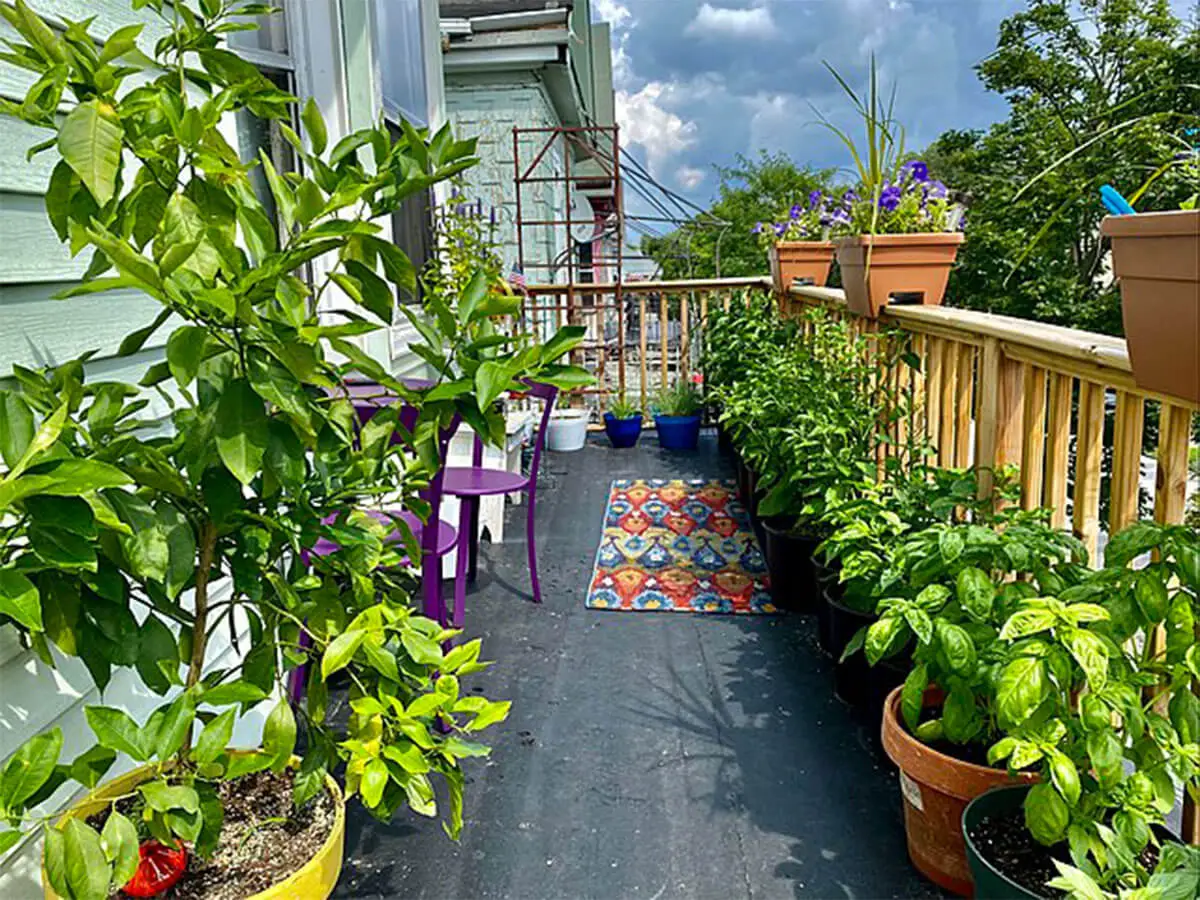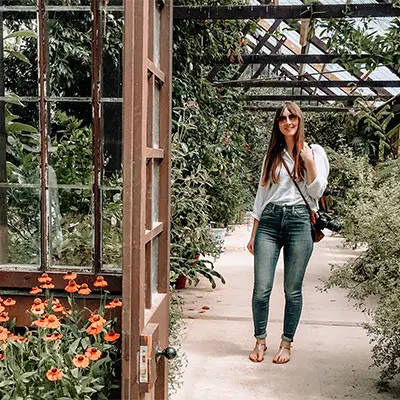A Guide to Balcony Vegetable Gardening
February, 2024 |Looking to start growing vegetables on your apartment balcony? Knowing what to buy and when to plant it may leave you wondering where to even begin. This guide will walk you through each step of balcony vegetable gardening. From choosing the best vegetables to grow on a balcony, filling planters, care and maintenance tips, and even how to deal with your balcony vegetable garden at the end of the season.
So whether you’re completely new to gardening, or simply looking for tips on growing veg in a smaller space, you’ll find something useful below…
Disclaimer: This post contains affiliate links. When you make a purchase through one of these links I may earn a commission. This comes at no extra cost to you.
How to grow vegetables on a balcony garden
If you’re a new gardener, growing vegetables for the first time can be daunting. It can be hard to know where to begin or what to invest in.
Below you’ll find a step-by-step walkthrough of balcony vegetable gardening, helping you garden with confidence!
Use these links to jump ahead to a section that’s useful to you. Or simply read through the guide for expert tips on how best to set up your balcony vegetable garden.
- Assess the conditions
- When to start your balcony vegetable garden
- What vegetables to grow on a balcony
- Choosing containers for a balcony vegetable garden
- Filling containers
- Tips for vertical vegetable gardening
- Maintenance and watering
- Harvesting
- Winter care tips and storage
Assess the conditions
Before you head down to the local nursery to start buying plants, you need a rough idea of the conditions your balcony faces.
Climate, weather, and sunlight exposure can all influence how well your balcony vegetable garden grows, so you need to know…
- roughly how much sunlight your balcony receives throughout the day.
- your USDA/climate zone
- if you’ll need to deal with extreme weather e.g. high winds, intense sunshine, or heavy snow
Most vegetables need between 6-8 hours to successfully produce fruit, so make sure to place vegetable plants on the sunniest part of your balcony. If your balcony has a lot of shade, there are plenty of shade tolerant vegetables and herbs you can grow.
Knowing the climate zone of your balcony garden can help you figure out when to plant vegetables outside. Usually, the main growing season for vegetables is from March to September. But this will vary depending on your climate zone and what you’d like to grow.
Knowing the conditions helps you choose the right vegetables to grow. But also when to plant, and how to care for them.
When to start a balcony vegetable garden
So you’re eager to start gardening vegetables on your balcony, when can you start?
Once you know the approximate growing season of your area (your USDA zone gives you an estimate) you can begin planning when to sow seeds or buy plants.
If you’re sowing seeds, you’ll need to start these early in the growing season. But if you’re buying plants from a local nursery, you can usually buy these in late spring or early summer. Knowing your USDA zone can help you plan this.
But once you’ve selected which balcony plants to grow, you’ll also find estimated planting times on the seed packets or vegetable plant care labels.
What vegetables to grow on a balcony
Some of the best vegetables to grow on a balcony include the old gardening classics. Tomatoes, cucumbers, beans, leafy greens, and herbs are all productive and fun to grow.
If you’re new to gardening, some of the easiest foods to grow on a balcony are tomatoes, beans, and zucchini. They’re relatively low maintenance and prolific, and you can use them in lots of recipes.
But the best advice is to simply grow whatever you like to eat, as long as it will fit in your space. From mini melon varieties and dwarf peas to healing herbs or unusual squash varieties.

If you’re looking to harvest as much as possible, opt for high yield vegetable plants or fast growing vegetables like pak choi, radishes, and lettuce. Choosing fruit and vegetable plants that grow vertically is also a great way to pack more into the space!
Skip down to vertical vegetable gardening…
Sowing from seed or buying young plants
This is where it’s useful to know your growing conditions and USDA zone. When buying plants you can either buy seeds or young vegetable plants.
More specialist vegetable plants may only be available as seeds. But you should be able to buy popular garden vegetables and herbs like tomatoes, basil, or zucchinis as young plants in spring.

Starting plants from seeds is extremely satisfying and rewarding. But you’ll need to start them at the right time and care for them well. In colder and more northern areas you may have to start seeds indoors. In very northern areas where sunlight is limited, you may have to invest in grow lights too.
So often, it’s easier to wait until spring and simply browse your local nursery for vegetable plants that you can plant out on your balcony straight away.
Choosing containers for a balcony vegetable garden
On a balcony vegetable garden, lightweight containers made from plastic are ideal. They’re easy to stack and store in winter and will be less heavy than wood, ceramic, or stone.
Balconies can often be exposed to high winds and harsh sunlight, so choosing a plastic container can help to lock in moisture too.
To maximize your growing space, you may be able to hang planters from balcony railings.
Related Read | Choosing the Best Containers for a Balcony Garden

Filling your containers
When container gardening, you’ll need to add in the soil for your plants to grow in.
If you have shallow planters, you can simply fill your containers with a good potting soil mix. To give your plants the best start, mix store-bought compost with some sand or perlite to provide good drainage and nutrients for your vegetable plants to thrive.
But for deeper planters, you could add the following…
- A drainage layer: made up of old sticks/logs. This gives the roots more space to grow and allows more oxygen to get to the roots making plants healthier.
- A layer of organic matter: e.g. you could also use old leaves, compost that’s not quite finished breaking down, or wood chip.
- A mix of fresh compost and nutrient-rich organic matter: e.g. leaf mould, manure, and store-bought compost bags.
- An optional layer of topsoil: e.g. native soil, or store-bought topsoil.
- An optional layer of mulch: for example wood chip or old leaves.
If you live in a hot or dry climate, adding a layer of mulch (e.g. leaf mulch, bark, etc.) can help to keep moisture in so you don’t need to water so much.
Carrying compost bags up to a vegetable balcony garden is no small feat… The following year you could use these steps to reuse old compost in containers. This can save you a few expensive and heavy trips to a garden nursery to pick up several bags of new compost.
Tips for vertical vegetable gardening on a balcony
When space is limited, one of the best tips for creating a balcony vegetable garden is to think vertically!
Creating a vertical vegetable garden can help you maximize your yield and make the most of space. Even on a tight budget, you can create DIY vertical supports using bamboo canes, trellises, etc.
For climbing vegetables like cucumbers, mini pumpkins, or beans, a planter placed next to a trellis like this can be a cheap option. Remember to secure any loose structures in place so they don’t fall over or off your balcony in high wind.

Maintenance and watering
Don’t forget to water regularly, but never overwater. The roots of vegetable plants will not enjoy being sat in wet, compact soil.
Most high-producing vegetable plants like tomatoes, watermelons, or zucchinis will need lots of water. So if your balcony is exposed to sunlight throughout the day, you may need to water your planters daily.
One trouble many gardeners face is caring for plants while away on a summer holiday. If no one is available to check in on your plants, there are a few watering set-ups you can use for your balcony garden, like drip irrigation. This is especially useful if you live in a hot, dry climate and find that you need to water every half a day!
Harvesting your balcony vegetable garden
Once fruits and vegetables begin to ripen in your balcony vegetable garden, start harvesting! Picking often will encourage your vegetable and herb plants to grow and produce more fruits and leaves, leading to a longer harvest.
Keep recipes on hand for all the vegetables you’re growing so you’ll always know how to cook with them. If you have excess vegetables, you could gift them to friends, family, and neighbors.

Saving seeds
If you love what you’ve grown this year, one of the best budget-friendly tips for a small garden is to save the seeds instead of rebuying seed packets or plants next year.
For beans, tie a piece of string or fabric around a healthy bean pod and wait for it to ripen and dry before. You can easily save the seeds of pumpkins, tomatoes, and summer squash by picking the seeds out, drying them on a paper towel, and storing them in a paper bag or plastic container for next year.
Note that if you have a hybrid plant, the seeds you collect will produce seedlings that will be different from the parent plant!
Winter care tips and storage
When autumn rolls around, most summer vegetable plants will have finished producing and plants will start to die back. Use this guide to autumn garden jobs to make sure your balcony vegetable garden is set for the approaching winter.
Reusing old compost…
You can reuse old compost in next year’s planters (as long as you supplement it with fresh organic matter). But instead of leaving bare soil in your planters, you could grow a winter cover crop to lock in nutrients into the soil like buckwheat or clover.
Related Read | A Guide to Growing Grains in a Small Garden
If you don’t want old compost hanging around and you’d like to stack and store your planters. Simply begin sprinkling old compost into your compost bin in layers. This helps to regenerate it into new compost you can use next year.
Related Read | A Guide to Hot Composting on a Balcony
Featured Image: Andre Carrotflower Creative Commons Attribution-Share Alike 4.0






